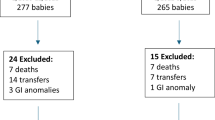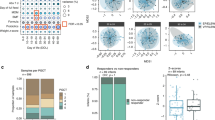Abstract
Background:
Specific probiotics prevent necrotizing enterocolitis (NEC). A mixture of lactobacilli and bifidobacteria (Infloran) was highly effective in Asian very-low-birth-weight (VLBW) infants. We analyzed the effect of Infloran on NEC, NEC severity, and the influence of enteral feedings (breast milk vs. formula) on NEC prevention in a cohort of European VLBW infants.
Methods:
Infloran was implemented for routine use at our department. VLBW infants receiving probiotics were prospectively followed (2010–2012) and compared with historic controls (2008–2009). Data on NEC, neonatal morbidity, feeding tolerance, and descriptive parameters on NEC cases were analyzed.
Results:
Infloran had no statistically significant impact on NEC (controls: 24/233 (10.3%); probiotics: 16/230 (7%); P = 0.2). However, NEC was significantly reduced in infants of the probiotics group who were fed any breast milk (20/179 (11.2%) vs. 10/183 (5.5%); P = 0.027), whereas it was ineffective in infants exclusively fed formula (4/54 (7.4%) vs. 6/44 (13.6%); P = 0.345). Occurrence of severe NEC (IIIb), time until full feeds, and gastric residuals were similar.
Conclusion:
Infloran was of lower efficacy in a European VLBW cohort and showed a reduction of NEC only in infants fed breast milk. Future studies should investigate the influence of feeding formula or breast milk on the effect of probiotics.
Similar content being viewed by others
Log in or create a free account to read this content
Gain free access to this article, as well as selected content from this journal and more on nature.com
or
References
Schnabl KL, Van Aerde JE, Thomson AB, Clandinin MT . Necrotizing enterocolitis: a multifactorial disease with no cure. World J Gastroenterol 2008;14:2142–61.
Lin PW, Stoll BJ . Necrotising enterocolitis. Lancet 2006;368:1271–83.
Berseth CL . Feeding strategies and necrotizing enterocolitis. Curr Opin Pediatr 2005;17:170–3.
McCallie KR, Lee HC, Mayer O, Cohen RS, Hintz SR, Rhine WD . Improved outcomes with a standardized feeding protocol for very low birth weight infants. J Perinatol 2011;31:Suppl 1:S61–7.
Sisk PM, Lovelady CA, Dillard RG, Gruber KJ, O’Shea TM . Early human milk feeding is associated with a lower risk of necrotizing enterocolitis in very low birth weight infants. J Perinatol 2007;27:428–33.
Kligler B, Cohrssen A . Probiotics. Am Fam Physician 2008;78:1073–8.
Borriello SP, Hammes WP, Holzapfel W, et al. Safety of probiotics that contain lactobacilli or bifidobacteria. Clin Infect Dis 2003;36:775–80.
Ohland CL, Macnaughton WK . Probiotic bacteria and intestinal epithelial barrier function. Am J Physiol Gastrointest Liver Physiol 2010;298:G807–19.
Williams NT . Probiotics. Am J Health Syst Pharm 2010;67:449–58.
Pagnini C, Saeed R, Bamias G, Arseneau KO, Pizarro TT, Cominelli F . Probiotics promote gut health through stimulation of epithelial innate immunity. Proc Natl Acad Sci USA 2010;107:454–9.
Corthésy B, Gaskins HR, Mercenier A . Cross-talk between probiotic bacteria and the host immune system. J Nutr 2007;137:Suppl 2:781S–90S.
Claud EC, Walker WA . Hypothesis: inappropriate colonization of the premature intestine can cause neonatal necrotizing enterocolitis. FASEB J 2001;15:1398–403.
Deshpande G, Rao S, Patole S, Bulsara M . Updated meta-analysis of probiotics for preventing necrotizing enterocolitis in preterm neonates. Pediatrics 2010;125:921–30.
Guthmann F, Kluthe C, Bührer C . Probiotics for prevention of necrotising enterocolitis: an updated meta-analysis. Klin Padiatr 2010;222:284–90.
Lin HC, Su BH, Chen AC, et al. Oral probiotics reduce the incidence and severity of necrotizing enterocolitis in very low birth weight infants. Pediatrics 2005;115:1–4.
Hoyos AB . Reduced incidence of necrotizing enterocolitis associated with enteral administration of Lactobacillus acidophilus and Bifidobacterium infantis to neonates in an intensive care unit. Int J Infect Dis 1999;3:197–202.
Farnworth ER . The evidence to support health claims for probiotics. J Nutr 2008;138:1250S–4S.
Bin-Nun A, Bromiker R, Wilschanski M, et al. Oral probiotics prevent necrotizing enterocolitis in very low birth weight neonates. J Pediatr 2005;147:192–6.
Garland SM, Tobin JM, Pirotta M, et al.; ProPrems Study Group. The ProPrems trial: investigating the effects of probiotics on late onset sepsis in very preterm infants. BMC Infect Dis 2011;11:210.
Ortega VE, Meyers DA . Pharmacogenetics: implications of race and ethnicity on defining genetic profiles for personalized medicine. J Allergy Clin Immunol 2014;133:16–26.
Bermudez-Brito M, Plaza-Díaz J, Muñoz-Quezada S, Gómez-Llorente C, Gil A . Probiotic mechanisms of action. Ann Nutr Metab 2012;61:160–74.
Netea MG, Wijmenga C, O’Neill LA . Genetic variation in Toll-like receptors and disease susceptibility. Nat Immunol 2012;13:535–42.
Meinzen-Derr J, Poindexter B, Wrage L, Morrow AL, Stoll B, Donovan EF . Role of human milk in extremely low birth weight infants’ risk of necrotizing enterocolitis or death. J Perinatol 2009;29:57–62.
Carlisle EM, Morowitz MJ . The intestinal microbiome and necrotizing enterocolitis. Curr Opin Pediatr 2013;25:382–7.
Zivkovic AM, German JB, Lebrilla CB, Mills DA . Human milk glycobiome and its impact on the infant gastrointestinal microbiota. Proc Natl Acad Sci USA 2011;108:Suppl 1:4653–8.
Ververidis M, Kiely EM, Spitz L, Drake DP, Eaton S, Pierro A . The clinical significance of thrombocytopenia in neonates with necrotizing enterocolitis. J Pediatr Surg 2001;36:799–803.
Stichtenoth G, Demmert M, Bohnhorst B, et al. Major contributors to hospital mortality in very-low-birth-weight infants: data of the birth year 2010 cohort of the German Neonatal Network. Klin Padiatr 2012;224:276–81.
Haque KN, Pammi M . Pentoxifylline for treatment of sepsis and necrotizing enterocolitis in neonates. Cochrane Database Syst Rev 2011;CD004205.
Klebermass-Schrehof K, Wald M, Schwindt J, et al. Less invasive surfactant administration in extremely preterm infants: impact on mortality and morbidity. Neonatology 2013;103:252–8.
Pronovost PJ, Angus DC, Dorman T, Robinson KA, Dremsizov TT, Young TL . Physician staffing patterns and clinical outcomes in critically ill patients: a systematic review. JAMA 2002;288:2151–62.
Oncel MY, Sari FN, Arayici S, et al. Lactobacillus reuteri for the prevention of necrotising enterocolitis in very low birthweight infants: a randomised controlled trial. Arch Dis Child Fetal Neonatal Ed 2014;99:F110–5.
Mihatsch WA, Vossbeck S, Eikmanns B, Hoegel J, Pohlandt F . Effect of Bifidobacterium lactis on the incidence of nosocomial infections in very-low-birth-weight infants: a randomized controlled trial. Neonatology 2010;98:156–63.
Ofek Shlomai N, Deshpande G, Rao S, Patole S . Probiotics for preterm neonates: what will it take to change clinical practice? Neonatology 2014;105:64–70.
Kitajima H, Sumida Y, Tanaka R, Yuki N, Takayama H, Fujimura M . Early administration of Bifidobacterium breve to preterm infants: randomised controlled trial. Arch Dis Child Fetal Neonatal Ed 1997;76:F101–7.
Rougé C, Piloquet H, Butel MJ, et al. Oral supplementation with probiotics in very-low-birth-weight preterm infants: a randomized, double-blind, placebo-controlled trial. Am J Clin Nutr 2009;89:1828–35.
Gregory KE, Deforge CE, Natale KM, Phillips M, Van Marter LJ . Necrotizing enterocolitis in the premature infant: neonatal nursing assessment, disease pathogenesis, and clinical presentation. Adv Neonatal Care 2011;11:155–64; quiz 165–6.
de Vries LS, Eken P, Dubowitz LM . The spectrum of leukomalacia using cranial ultrasound. Behav Brain Res 1992;49:1–6.
Volpe JJ . Intraventricular hemorrhage and brain injury in the premature infant. Diagnosis, prognosis, and prevention. Clin Perinatol 1989;16:387–411.
Kling PJ, Hutter JJ . Hematologic abnormalities in severe neonatal necrotizing enterocolitis: 25 years later. J Perinatol 2003;23:523–30.
Benkoe T, Reck C, Gleiss A, et al. Interleukin 8 correlates with intestinal involvement in surgically treated infants with necrotizing enterocolitis. J Pediatr Surg 2012;47:1548–54.
Author information
Authors and Affiliations
Corresponding author
PowerPoint slides
Rights and permissions
About this article
Cite this article
Repa, A., Thanhaeuser, M., Endress, D. et al. Probiotics (Lactobacillus acidophilus and Bifidobacterium bifidum) prevent NEC in VLBW infants fed breast milk but not formula. Pediatr Res 77, 381–388 (2015). https://doi.org/10.1038/pr.2014.192
Received:
Accepted:
Published:
Issue date:
DOI: https://doi.org/10.1038/pr.2014.192
This article is cited by
-
Impact of perinatal administration of probiotics on immune cell composition in neonatal mice
Pediatric Research (2024)
-
Probiotic supplementation in neonates with congenital gastrointestinal surgical conditions: a pilot randomised controlled trial
Pediatric Research (2022)
-
Therapeutic applications and biological activities of bacterial bioactive extracts
Archives of Microbiology (2021)
-
Indole-3-lactic acid, a metabolite of tryptophan, secreted by Bifidobacterium longum subspecies infantis is anti-inflammatory in the immature intestine
Pediatric Research (2020)
-
Standardized feeding and probiotic supplementation for reducing necrotizing enterocolitis in preterm infants in a resource limited set up
European Journal of Clinical Nutrition (2018)



